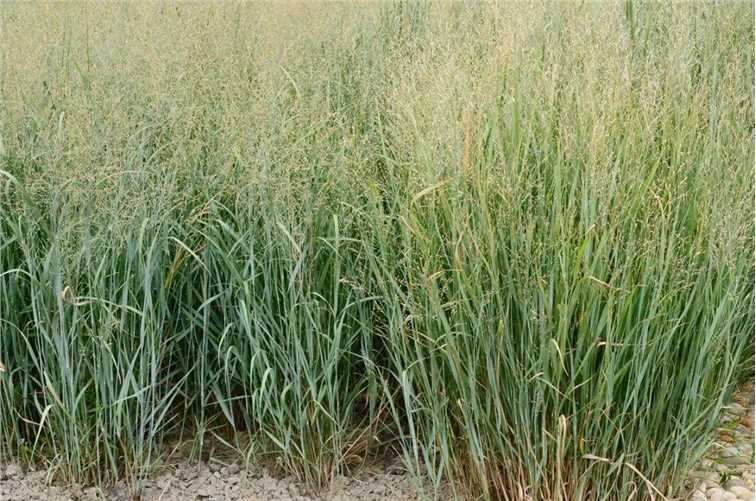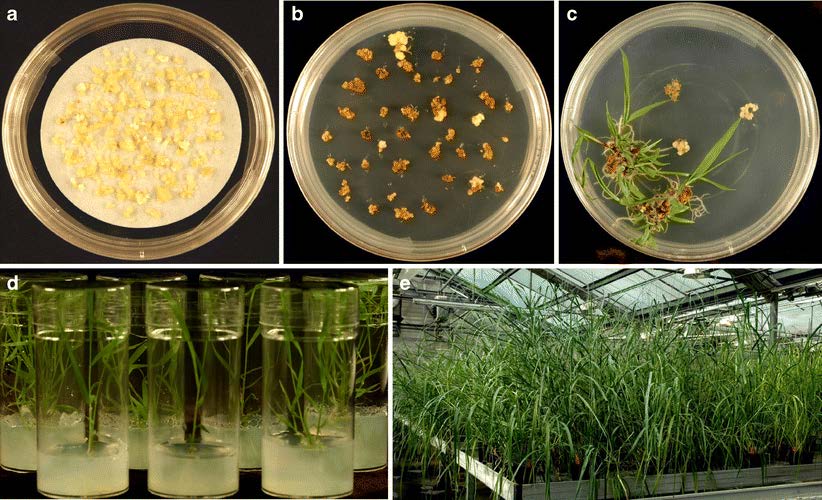Panicum virgatum L., also known as switchgrass, is a perennial grass of the Gramineae family, with scaled rhizome, upright and high stem, hard texture. Panicum virgatum L. is produced in North America. The planting cost is low, the growth is rapid, the maximum yield can reach 74 tons/ha, and it has strong adaptability to the environment. Switchgrass can be used as forage grasses and wind barrier plants. Besides, it plays an important role in soil and water conservation. At the same time, because of its high cellulose content, ethanol conversion efficiency can reach 57%, so it is also a raw material for biofuels and alternative energy production. Lifeasible, as a world class phytotechnology company, offers well-established platform for switchgrass transformation to help you to improve disease resistance, insect resistance, salt tolerance, cold tolerance, cellulose content of swichgrass.

Lifeasible provides one-stop services, covering all steps including experimental design, vector construction, plasmid transformation, positive transplant screening and characterization of transgenic Panicum virgatum L., our various genetic modification services are as follows:
Gene overexpression is a common technique for studying gene function. The development and utilization of gene overexpression has brought us many conveniences for studying gene function and improving the yield of target products. Through the quantitative overexpression of genes related to cellulose, hemicellulose, lignin, and other chemical components in Panicum virgatum L., Thereby increasing the yield of specific compounds. We could help you overexpress many genes including PvTCP gene family that affects salt resistance, genes PvMAX2 and TB1/FC1 that affect switchgrass tiller formation, Anti-stress response gene PvbZIP, MiR393a, which regulates auxin signal transduction and expression of cold tolerance related genes, gene PvHsp20 that affects drought resistance. and many other genes related to important traits of Panicum virgatum L.
RNAi technology is widely used in the field of gene editing, it is a phenomenon of specific gene silencing mediated by double-stranded RNA (dsRNA) at the transcription level and translation level. Through RNAi technology, we can achieve silencing of multiple genes in Panicum virgatum L.
Virus induced gene silencing (VIGS) is a genetic technology that inhibits the expression of endogenous genes in plants by inserting recombinant viruses into target gene segments, they can induce plant endogenous gene silencing and cause phenotypic changes, and then study the function of target genes based on phenotypic changes. The VIGS technology is a method of transient transformation and underlying molecular basis may be post-transcriptional gene silencing. Silencing and functional analysis of target genes in Panicum virgatum L. through VIGS can help our customers save time and achieve valuable information for gene functional analysis. With wealth of experience in VIGS, our scientists in Lifeasible can provide you with customized protocol for VIGS in Panicum virgatum L.
CRISPR gene knockout technology is currently the most widely used gene knockout technology, it provides us with a very powerful and convenient gene editing tool. As a leading company that has been deeply involved in the field of gene editing for many years, with CRISPR technology, we can knockout Panicum virgatum L. genes in different ways, including frameshift mutations, multiple deletion of fragments, knockout of non-coding genes, knockout of multiple copies of genes, etc.
CRISPR system has strong scalability, and this scalability can be used to develop more useful gene editing tools. we have developed many methods that can improve gene knock-in efficiency and achieve precise editing of the Panicum virgatum L. genome. For the gene knock-in process, most of CRISPR gene knock-in is done through HDR. However, NHEJ and HDR will occur at the same time due to DNA breaks. Therefore, we have developed different methods to increase the probability of HDR, thereby improving the efficiency of gene knock-in.
CRISPR single base editing technology is a hot area of life science research today. As a company that has been cultivating gene editing technology for decades, Lifeasible could help you achieve the conversion from C to T or A to G in Panicum virgatum L. using CBE and ABE, both of which rely on the DNA positioning capabilities of the CRISPR/Cas9 system. During single base editing, the C base deaminase or A base deaminase is located at a specific position in the genome, and it catalyzes the deamination reaction of C or A at a specific position and turns it into U or I. Then it is treated as T or G in the process of DNA replication, realizing the conversion from C to T or A to G.
Sequence-specific control of gene expression on a genome-wide scale is an important approach for understanding gene functions and for engineering genetic regulatory systems. There are many ways to participate in the inhibition of gene expression, one of them is CRISPR Interference (CRISPRi). For the inhibition of Panicum virgatum L. genes, we can provide a variety of solutions, including dCas9 binding to targeted DNA and realizing Inhibition of gene transcription through steric hindrance. In addition, gene knockdown can also be achieved by recruiting a fusion protein to the start site of gene transcription.
CRISPRa technology uses the powerful capabilities of Cas9 and sgRNA to fuse or recruit multiple proteins to enhance gene transcription. For Panicum virgatum L. genes, we provide VPR technology, SAM technology and Suntag technology to allow the CRISPR system to carry more activation element and achieve a stronger activation effect after synergistic amplification.
The study of gene function has always been the core subject of biological research. The earliest genetic screening system established through forward genetics is very inefficient and has a huge workload. However, the reverse genetic screening system based on CRISPR technology can complete very low-cost mutation library construction work. The gene mutation library construction technology we provide for Panicum virgatum L. including gene knockout library construction, gene knockdown library construction, and gene activation library construction. Moreover, single-cell sequencing is available for mutation screening.
DNA-free gene editing technology has received extensive attention from the industry in recent years. We provide DNA free Panicum virgatum L. genome editing services, including transient expression of CRISPR/Cas9 plasmid DNA, in vitro transcription of CRISPR/Cas9, and pre-assembled ribonucleic acid composed of purified Cas9 protein and sgRNAs complex. These technologies can avoid the integration of foreign DNA and genome, and reduce off-target effects. In addition, compared with traditional techniques, these techniques can avoid the use of hybridization or backcrossing to isolate CRISPR/Cas9 chimeras, so they are cheaper and have shorter experimental cycles.
Genetic Transformation Process for Panicum virgatum L.
Plant gene transformation technology is a basic technology for studying plant gene functions and obtaining excellent plant traits. Lifeasible has established a mature Agrobacterium-mediated transformation platform for Panicum virgatum L.. Briefly, the embryogenic calli are induced and cocultured with Agrobacterium, then shoot and root are regenerated to get a whole plant.
 Figure 1. Transgenic switchgrass (Panicum virgatum L.) plants obtained after Agrobacterium-mediated transformation, (a) Embryogenic calli co-cultivated with Agrobacterium on a filter paper disk, (b) Hygromycin-resistant calli obtained 6 weeks after Agrobacterium-mediated transformation and selection, (c) Regeneration of shoots/plantlets from hygromycin-resistant calli, (d) Well-rooted transgenic plants obtained 4 weeks after transferring the regenerated shoots to rooting medium, (e) Greenhouse-grown transgenic plants obtained 5 months after Agrobacterium-mediated transformation. (Xi Y, et al. 2009)
Figure 1. Transgenic switchgrass (Panicum virgatum L.) plants obtained after Agrobacterium-mediated transformation, (a) Embryogenic calli co-cultivated with Agrobacterium on a filter paper disk, (b) Hygromycin-resistant calli obtained 6 weeks after Agrobacterium-mediated transformation and selection, (c) Regeneration of shoots/plantlets from hygromycin-resistant calli, (d) Well-rooted transgenic plants obtained 4 weeks after transferring the regenerated shoots to rooting medium, (e) Greenhouse-grown transgenic plants obtained 5 months after Agrobacterium-mediated transformation. (Xi Y, et al. 2009)
Lifeasible offers our customers with professional one-stop services, covering all steps including experimental design, vector construction, plasmid transformation, positive transplant screening and testing. Adapting to diverse purposes of different customers, multiple Agrobacterium strains (LBA4404, GV3101, EHA105, AGL1, C58, GV2260), as well as commercial and customized binary vectors with variant selectable markers (Kanamycin, Hygromycin, Phosphinothricin, G418, etc.) are available. Experts at Lifeasible obtain years of experience to solve technical problems and challenges in Panicum virgatum L. transformation. We can draw customized solution for you. For more information or any inquiry requirements, please contact Lifeasible.
Reference